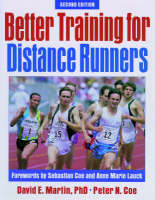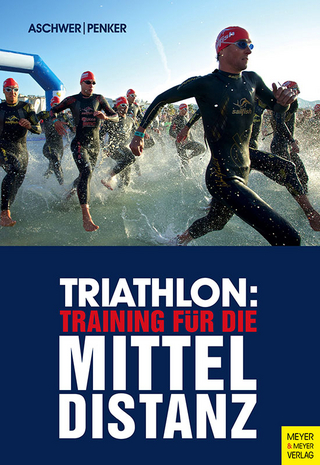
Better Training for Distance Runners
Human Kinetics Publishers (Verlag)
978-0-88011-530-8 (ISBN)
- Titel ist leider vergriffen;
keine Neuauflage - Artikel merken
This text integrates scientific principles about how the body adapts to training with practical information on designing individualized training programmes for middle- and long-distance runners. It covers: the biomechanics and biochemistry of running; goal-setting for competitive runners; developing a plan for total body fitness; strategies for successful racing from the 800-metre through the marathon; integrating psychological and psychiological aspects of athlete development; and stress management.
No two authors are better qualified than David Martin and Peter Coe to address both the physiology and coaching of distance running. Martin has served as marathon chair of USA Track & Field`s (USATF) Men`s Development Committee since 1979 and as chair of the national governing body`s Sport Science Subcommittee since 1984. These positions have allowed him to coach, advise, and scientifically evaluate many of America`s best men and women distance runners. They have also provided him the opportunity to work with and learn from other top coaches and sports scientists around the world. A fellow of the American College of Sports Medicine, Martin is the author of four books, including The High Jump Book, The Marathon Footrace, and Training Distance Runners. He also is a contributor to New Studies in Athletics, the technical journal of the International Amateur Athletic Federation. Dr. Martin is a regents professor of health sciences at Georgia State University, which has three times honored him as a distinguished professor. He is also a results statistician for the Association of International Marathons and the Association for Track & Field Statisticians. Peter Coe has successfully coached domestic and foreign runners at all levels, but he is probably best known for guiding his son Sebastian to one of the greatest middle distance running careers of all time. Under Peter`s tutelage, Sebastian won two Olympic gold medals in the 1500-meter run and two Olympic silver medals in the 800-meter run; a bronze, a silver, and a gold at the European championships; and 12 world records. A retired engineer, Coe is a recognized international lecturer and a writer. He is author of Training Distance Runners and Winning Running. Coe was presented the Senior Coaching Award by the British Athletics Association and was named Coach of the Year by the British Milers` Club--an organization for which he served as chairman for several years.
Chapter 1. The Biomechanics of Running Kinesiology: The Study of Movement Running-Specific Movement Interesting Questions About Running Biomechanics Evaluating and Improving Running Biomechanics Summary: Using Biomechanics Effectively References Chapter 2. Muscle Physiology for Running Anatomic Aspects of Neuromuscular Integration Generation of Muscle Tension Skeletal Muscle Fiber Types Effects of Training on Skeletal Muscle Performance Summary: Using Muscle Physiology for Better Training References Chapter 3. The Energy Dynamics of Running Thermodynamics Made Easy Energy Storage in Tissues: ATP and CP The Four Energy Systems Comparing Aerobic and Anaerobic Metabolism Comparing Carbohydrates and Fatty Acids as Fuels Metabolism of Carbohydrates Metabolism of Fats: Aerobic Lipolysis Interaction of Carbohydrate and Fat Metabolism During Exercise Summary: Better Training Through Chemistry References Chapter 4. Heart, Lung, and Blood Adaptations to Running Aerobic and Anaerobic Contributions to Performance Physiological Indicators of Performance Exercise as a Challenge to the Heart, Lungs, and Blood Measuring Cardiopulmonary Fitness in the Laboratory Summary: Training and Monitoring the Heart and Lungs for Better Running References Chapter 5. Developing Running With Periodization Training Goal Setting Principles of Periodization Periodization Using Multi-Tier Training Constructing Your Own Effective Training Plan Suggestions for Better Use of Multi-Tier Training Using Altitude Training as a Fitness-Enhancing Stimulus Keep a Training Diary Summary: Building Better Fitness by Running References Chapter 6. Developing Total Fitness Adapting Muscles to Stress Loading Flexibility: The Essence of Joint Motion Body Composition: Importance and Measurement Summary: Running Improvement Through Total-Body Conditioning References Chapter 7. Preparing to Race General Concepts for Race Preparation The 800-Meter Run The 1,500-Meter Run The Steeplechase The 5,000-Meter Run The l0,000-Meter Run Road Racing The Marathon Preparing for and Delivering Successful Competitions Summary: Running Your Best Race References Chapter 8. Managing Balanced Training Fatigue: A Natural Consequence of Training Muscle Soreness and Connective Tissue Injury Overtraining and Staleness: Beyond Fatigue Preventing Overtraining Summary: Extending a Running Career References
| Erscheint lt. Verlag | 14.3.1997 |
|---|---|
| Vorwort | Seb Coe, Anne Marie Luack |
| Zusatzinfo | 180 illustrations |
| Verlagsort | Champaign |
| Sprache | englisch |
| Maße | 216 x 279 mm |
| Gewicht | 1293 g |
| Themenwelt | Sachbuch/Ratgeber ► Sport ► Leichtathletik / Turnen |
| ISBN-10 | 0-88011-530-0 / 0880115300 |
| ISBN-13 | 978-0-88011-530-8 / 9780880115308 |
| Zustand | Neuware |
| Haben Sie eine Frage zum Produkt? |
aus dem Bereich


